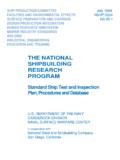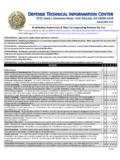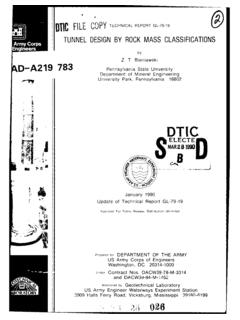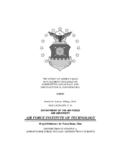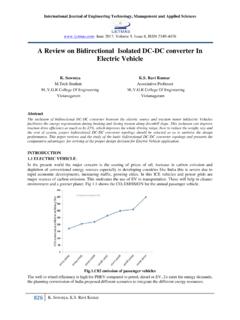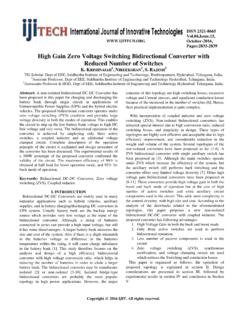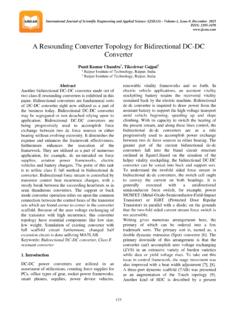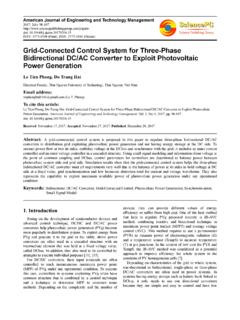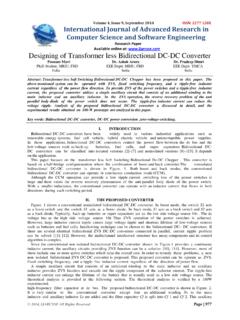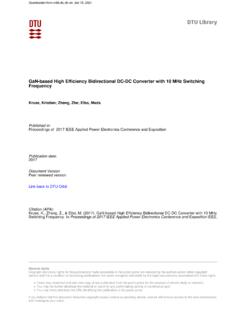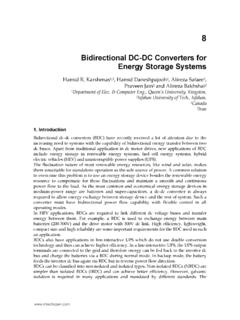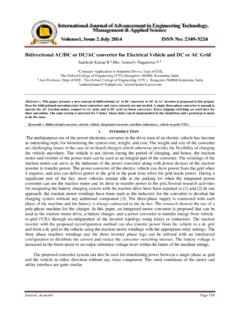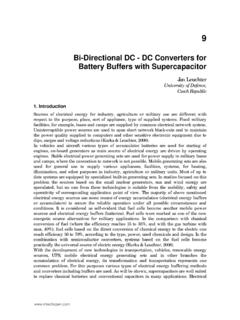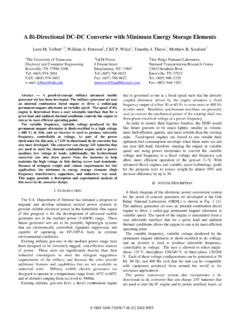Transcription of Isolated Bidirectional DC-DC Converter for Hybrid Electric ...
1 "Approved for public release: distribution is unlimited". Isolated Bidirectional DC-DC Converter for Hybrid Electric Vehicle Applications Sonya Gargies US Army TARDEC, 6501 East 11 Mile Road, Warren, MI 48397-5000. Hongjie Wu and Chris Mi Department of Electrical and Computer Engineering, University of Michigan, Dearborn, MI 48128. ABSTRACT powered by gasoline, methanol, compressed natural gas, hydrogen, or other alternative fuels. Hybrid Electric Hybrid Electric vehicles (HEVs) offer many advantages, vehicles have the potential to be two to three times more such as high fuel economy, low emissions, and silent fuel-efficient than conventional vehicles. An HEV is an operation. In HEVs, there are two or more different optimized mix of various components. The integration of voltage buses for different purposes of the vehicle these power-producing components with the electrical operation.
2 There are needs of galvanically Isolated energy storage components allows for many different Bidirectional DC-DC Converter to link different DC types of HEV designs. A power control strategy is voltage bus and transfer energy back and forth. For needed to control the flow of power and to maintain example, on of the DC-DC converters convert the high adequate reserves of energy in the storage devices. voltage (200-300V) in the main battery to low voltage Although this is an added complexity that is not found in (~12V) for use in electrical equipment, while the other conventional vehicles, it allows the components to work converts 300V battery voltage and supply the drive together in an optimal manner to achieve multiple design motor with 500V. High efficiency, compact size, objectives, such as high fuel economy and low lightweight, and reliability are all essential requirements emissions while maintaining or improving performance for DC-DC converters for Electric and Hybrid vehicles.
3 Such as acceleration, range, noise, silent operation, etc. This paper introduces a Bidirectional , Isolated DC-DC The control strategy brings the components together as Converter for medium power applications. A dual full- a system and provides the intelligence that makes the bridge topology is developed to achieve the power components work together through mechanical and rating. A 1kW prototype of the Converter has been built electrical control. Mechanical control includes clutch and tested. The experimental results of the Converter 's control, throttle control, and other controls activated steady state operation confirm the simulation analysis. mechanically by the driver from the car's interior. This Converter is a first step to understanding the design Electrical control will most likely be the dominant means and build of a medium power DC-DC Converter .
4 Of implementing control strategies. This will be done through software programs running on microchips that Key words: Power Converter , DC-DC , Hybrid Electric then activate relays and other electromechanical Vehicle, Battery, Galvanically Isolation systems to perform the desired functions. These computing systems will have multiple data inputs I. INTRODUCTION measured on the current state of the vehicle (such as component temperatures, battery voltage, current, and Hybrid Electric vehicles (HEVs) combine the internal state of charge) as well as the standard desired combustion engine of a conventional vehicle with the response requested by the driver (such as braking and battery and Electric motor of an Electric vehicle. The acceleration). This is all due to the increased use of on- combination offers low emissions while provides board computers in current and future vehicles.
5 One comparable driving range and convenient fueling of main component for the control of power is a DC-DC . conventional (gasoline and diesel) vehicles without the Converter . In Hybrid vehicles, the DC-DC Converter need to be plugged in. The inherent flexibility of HEVs converts the high voltage (200-300V) in the main battery makes them suited for personal transportation and to low voltage (14-42 V) or higher voltage (400-600V) for military applications. HEVs are powered by an on-board use in electrical equipment, thereby serving as an energy source (gasoline or diesel engine), an energy electrical unit that is indispensable for use in the next conversion unit (such as a combustion engine or fuel generation of clean energy vehicles. High efficiency, cell) and an energy storage device (such as batteries or compact size, lightweight, and reliability are all essential ultracapacitors).
6 The energy conversion unit may be requirements for DC-DC converters for Electric and Form Approved Report Documentation Page OMB No. 0704-0188. Public reporting burden for the collection of information is estimated to average 1 hour per response, including the time for reviewing instructions, searching existing data sources, gathering and maintaining the data needed, and completing and reviewing the collection of information. Send comments regarding this burden estimate or any other aspect of this collection of information, including suggestions for reducing this burden, to Washington Headquarters Services, Directorate for Information Operations and Reports, 1215 Jefferson Davis Highway, Suite 1204, Arlington VA 22202-4302. Respondents should be aware that notwithstanding any other provision of law, no person shall be subject to a penalty for failing to comply with a collection of information if it does not display a currently valid OMB control number.
7 1. REPORT DATE 2. REPORT TYPE 3. DATES COVERED. 13 JUN 2006 N/A - 4. TITLE AND SUBTITLE 5a. CONTRACT NUMBER. Isolated Bidirectional DC-DC Converter for Hybrid Electric Vehicle 5b. GRANT NUMBER. Application 5c. PROGRAM ELEMENT NUMBER. 6. AUTHOR(S) 5d. PROJECT NUMBER. Sonya Gargies; Hongjie Wu; Chis Mi 5e. TASK NUMBER. 5f. WORK UNIT NUMBER. 7. PERFORMING ORGANIZATION NAME(S) AND ADDRESS(ES) 8. PERFORMING ORGANIZATION REPORT. NUMBER. US Army RDECOM-TARDEC 6501 E 11 Mile Rd Warren, MI. 48397-5000, USA 15669. 9. SPONSORING/MONITORING AGENCY NAME(S) AND ADDRESS(ES) 10. SPONSOR/MONITOR'S ACRONYM(S). TACOM/TARDEC. 11. SPONSOR/MONITOR'S REPORT. NUMBER(S). 15669. 12. DISTRIBUTION/AVAILABILITY STATEMENT. Approved for public release, distribution unlimited 13. SUPPLEMENTARY NOTES. The original document contains color images. 14. ABSTRACT.
8 15. SUBJECT TERMS. 16. SECURITY CLASSIFICATION OF: 17. LIMITATION 18. NUMBER 19a. NAME OF. OF ABSTRACT OF PAGES RESPONSIBLE PERSON. a. REPORT b. ABSTRACT c. THIS PAGE. SAR 8. unclassified unclassified unclassified Standard Form 298 (Rev. 8-98). Prescribed by ANSI Std Z39-18. Hybrid vehicles, but an important concern is how to considerations, etc. A high priority should also be given increase efficiency. to increasing the power density by increasing the switching frequency and level of component integration;. DC-DC converters are switching regulators that offer however this paper is focused on understanding how the higher efficiency than linear regulators. They can step- DC-DC Converter works and what are the critical issues up, step-down, and invert the input voltage. Switching involved in the design and construction. regulators use an inductor, transformer, or a capacitor as an energy storage element to transfer energy from II.
9 THE PROPOSED DC-DC Converter . input to output. Feedback circuitry regulates the energy transfer to maintain a constant voltage or constant There are many different types of DC-DC converters current within the load limits of the circuit. available, each of which is more suitable for some type of application. Some converters are only suitable for Army HEVs are designed to use a high-voltage DC bus stepping down the voltage, while others for stepping up to supply high power electrical subsystems that may the voltage, and a third group can be for either. An benefit from a variable-voltage bi-directional DC-DC important distinction is full isolation between their input Converter to interface between the main storage battery and output circuits. Non- Isolated converters are pack and the high-voltage bus. The use of such a DC- generally used where the voltage needs to be stepped DC Converter has the potential to improve overall up or down.
10 The main types of Converter in non- efficiency, fuel economy, reliability, and safety, with the isolating group are buck, buck-boost, c k, and charge- proper controls and feedback circuitry. It would allow a pump converters, which are used for either step up or battery pack operating at a low voltage to supply higher voltage inversion in relatively low power applications. voltage to the vehicle. To provide these advantages For applications where the output needs to be (efficiency, fuel economy, reliability, and safety) and to completely Isolated from the input, isolating converters meet Army goals for enhanced sustainability, are implemented. The two main isolating converters are transportability and maintainability, it is desirable that the the flyback and fly forward converters that both depend Converter be compact, lightweight, and efficient.


